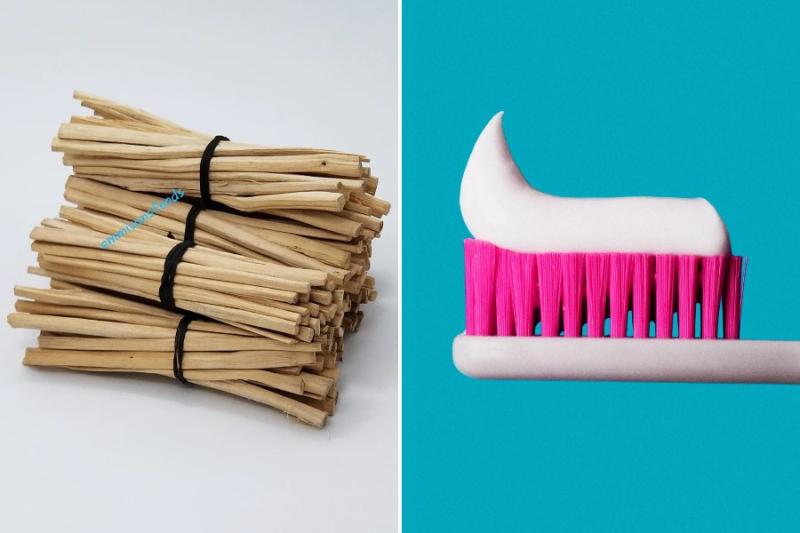A toothpick is a small, pointed stick to clean food particles from the teeth. On the other hand, a toothbrush is a bristled tool used to clean teeth, gums, and the tongue. The main distinction is that toothpicks are used to remove food particles, whereas toothbrushes are used to clean teeth and promote oral hygiene.
What is Toothpick?
After eating, a toothpick is used to clean the teeth. Toothpicks have one pointed end and one flat or blunt end. They are held between the thumb and fingers and inserted between the teeth to remove food or debris. Toothpicks are used daily with brushing and flossing. Some toothpicks are flavoured or coated with dental floss for better teeth cleaning. Toothpicks can damage gums and tooth enamel, so use them gently. Consult a dentist for questions about using toothpicks in your oral hygiene routine.
Toothpicks used to be ivory, bone, or metal. Ancient Greeks, Romans, and Chinese used toothpicks. Today, supermarkets, pharmacies, and online retailers sell toothpicks made of wood or plastic. Toothpicks have other uses besides oral hygiene. They can hold appetizers like olives or cheese cubes. Miniature models and sculptures can be made with toothpicks. Brushing, flossing, and dental checkups are the best ways to prevent tooth decay and gum disease. Toothpicks can help maintain oral hygiene but should not replace brushing and flossing. Consult a dentist if you experience toothpick pain, bleeding, or oral health concerns.
What is a Toothbrush?
Brushing your teeth regularly can help prevent tooth decay, gum disease, and bad breath. Toothbrushes are essential for maintaining good oral hygiene because they remove food particles, bacteria, and other debris from the surface of the teeth and gums. A toothbrush is a small brush used to clean teeth that typically includes a handle, bristles, and a head that holds the bristles in place. Toothbrushes come in various shapes, sizes, and designs, but they all have the same purpose: to remove plaque and debris from the teeth and gums.
Toothbrushes can be made of various materials, such as nylon, natural fibres, and rubber. They can also be manual or electric, with electric toothbrushes typically featuring rotating or oscillating bristles for more thorough cleaning. Toothbrushes should be replaced regularly to ensure that they continue to remove plaque and debris from teeth and gums. Brushes should be replaced every three to four months or sooner if the bristles become frayed or worn. Brushes, in general, are an essential tool for maintaining good oral hygiene and preventing tooth decay and gum disease. Individuals can help keep their teeth and gums healthy for a lifetime by using a toothbrush regularly and replacing it as needed.
Difference Between Toothpick and Toothbrush
Even though they help keep your mouth clean, toothpicks and toothbrushes do specific things. A toothpick is a thin instrument used to clean between teeth after a meal. They can be made of plastic or wood. Toothpicks can be placed between teeth to remove food lodged there. They are meant to work in tandem with regular brushing rather than as a replacement for it.
Conversely, a toothbrush is an implement for cleaning one’s teeth and gums. It is used to clean the teeth and gums of plaque, bacteria, and food particles and is typically made of bristles on an attached handle. A wide variety of toothbrushes are available to meet everyone’s specific requirements and aesthetic tastes. Nothing beats using a toothbrush to avoid cavities, gum disease, and other oral health issues. Brushes, instead of toothpicks, are the superior tool for routine dental care. Using something other than a toothpick to clean your teeth thoroughly and eliminate plaque and bacteria would be best. In sum, toothpicks and toothbrushes each have their place when it comes to maintaining good oral health. Toothbrushes are the superior tool for cleaning teeth and gums, while toothpicks are used to remove food particles between the teeth.






